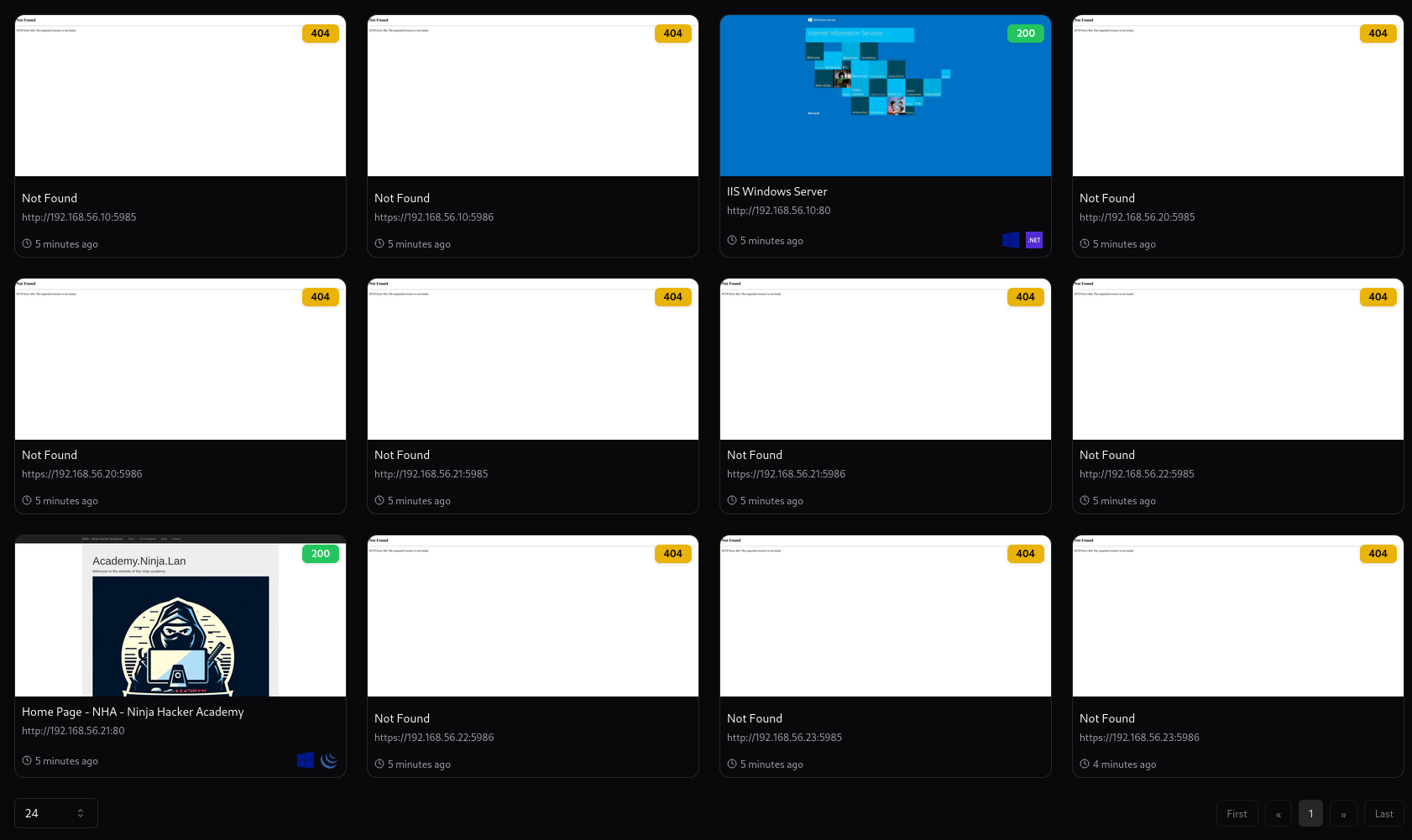NHA - Part 1 - Recon
NHA Part 1
Recon and Scanning
Lab Provided By: Mayfly - GOADv3
Scenario:
You've been hired to do a pentest for the Ninja Hacker Academy! there are flags throughout the machines you have been asked to collect and report back once you are complete. The environment does have Windows Defender but no one will stop you if payloads are caught. "Best of luck!" was all they said during the kick off meeting
Scanning
We will start off with a classic nmap scan, get a quick lay of the land and see what machines are available to us:
sudo nmap -sT -Pn -v -PE -T4 --open -p 21,22,23,25,80,110,139,143,389,443,445,636,1433,3000,3128,3306,3389,5432,5000,5985,5986,6667,8000,8010,8020,8080,8443,8888,10443 192.168.56.0/24 -oA flyover-nha
Why Use Sudo?
Its been observed that using sudo for nmap can result in better scanning, possibly due to the root privleges allowing for more privleged detection methods:
See: Here
In a true engagement, I have heard of people leveraging Qualys or Nessus to do this preliminary scanning! Then taking the results and using targeted nmap scans - The inverse is also true, you could take a large nmap scan and then leverage the results for your vulnerability scanning (which is outside the scope of this lab)
Parsing our results
Getting alive IPs
A very simple way to get our alive IPs is just via a basic cat, grep, cut.
cat scan.gnmap | grep Up | cut -d ' ' -f 2
Giving us the following results:
192.168.56.10
192.168.56.20
192.168.56.21
192.168.56.22
192.168.56.23
- You may have a
192.168.56.1address but that would be ... well you! so we can exclude it from our list
Enumerate web services
Another thing we could do is enumerate web services - Now the list we have here is quite small but in a larger environment it may be worth while to use tools such as gowitness to audit any web services to see what they are.
gowitness scan nmap -f nmapfile.xml --write-db
- Have a nessus file? check the help pages! you can use that as well!
You can then view a nice interface to view your results with the following
gowitness report server
- Depending on how you're routing web traffic / have your kali setup you may need to use the
--hostflag and make some adjustments
Example output:

We can quickly check that IIS server for enrollment https://{ip}/certsrv/certfnsh.asp but no luck.
That gives us a potential option of the http://192.168.56.21 web application
- We will make a note of that and continue finishing our recon
Configure our environment
Next we can do a quick sweep with nxc and prep our environment a little
- Should we adjust our /etc/hosts?
- On larger engagements this will be impractical (and hopefully in an "assumed breach" scenario, the VM you have is setup properly), however it is still good information if you need to ensure your traffic routes properly to a specific workstation/DC
- How about krb5.conf
- Get that setup properly as well
- Same notes about practicality as above but still worth remember it could be something for troubleshooting
- Get that setup properly as well
Sweeping with nxc
nxc smb ips
- Where
ipsis a file with the ips we discovered
Results in the following:

Editing /etc/hosts
# NHA
192.168.56.10 DC-VIL.ninja.hack ninja.hack DC-VIL
192.168.56.20 DC-AC.academy.ninja.lan academy.ninja.lan DC-AC
192.168.56.21 web.academy.ninja.lan web
192.168.56.22 sql.academy.ninja.lan sql
192.168.56.23 share.academy.ninja.lan share
- You can place the above into your /etc/hosts
Editing /etc/krb5.conf
- If you dont have this and are using a debian based distro (Kali)
sudo apt-get install -y libkrb5-dev
[libdefaults]
default_realm = ninja.hack
kdc_timesync = 1
ccache_type = 4
forwardable = true
proxiable = true
fcc-mit-ticketflags = true
[realms]
ninja.hack = {
kdc = dc-vil.ninja.hack
admin_server = dc-vil.ninja.hack
}
academy.ninja.lan = {
kdc = dc-ac.academy.ninja.lan
admin_server = dc-ac.academy.ninja.lan
}
Check for user list
Theres a lot of ways to try and do this - a couple of good ones:
nxc ldap {DCIP} -u guest -p '' --users
or
lookupsid.py anonymous@$DCIP
There is many more you can google/look up, but no luck today!
Check for shares
enum4linux-ng -U $TARGET
enum4linux-ng -U $DCIP
Again no such luck but if you had a set of creds in assumed breach, or found a set with a bit of OSINT you could try the above again.
Generate a Relay List
We should generate potential smb relay targets, smb allows us to do this quickly:
nxc smb 192.168.1.0/24 --gen-relay-list relay_list.txt
Listen and Poison
We could also potentially listen and poison for hashes with Responder
Responder -I {interface}
- You can also use
-Aif you just want to analyze the traffic
But alas, no such luck again.
What have we learned so far?
- We have learned we have 2 domains
ninja.hackand a child domainacademy.ninja.lan - Two DCs
DC-VILandDC-AC - Reviewing our
nxcoutput- The DCs have SMB Signing enabled
- All machines appear to be using SMBv2
- However signing is off on a few of them so SMB relays may still be abuseable
- See hackndo for better - more accurate information.
- As mentioned above and in this article also means if you see smbv1 set to true with signing set to true you should still add them as smbv1 doesnt enforce signing inherently
- See hackndo for better - more accurate information.
- However signing is off on a few of them so SMB relays may still be abuseable
Wrapping Up
- For now that should be sufficient to get us started and we can begin looking at the web application
- Should we find any credentials we can use similar functions + more to try and get more information and repeat the process